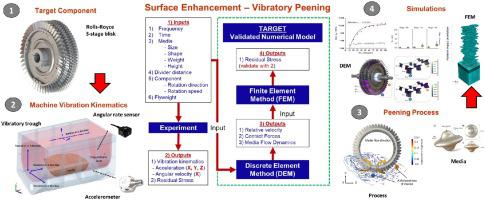Journal of Materials Processing Technology ( IF 6.7 ) Pub Date : 2021-09-21 , DOI: 10.1016/j.jmatprotec.2021.117383 Joselito Yam Alcaraz 1, 2 , Jing Zhang 1, 2 , Arun Prasanth Nagalingam 1, 2, 3 , Sharan Kumar Gopasetty 1, 2 , Boon Loong Toh 1, 2 , Abhay Gopinath 3 , Kunal Ahluwalia 4 , Marcus Guo Wei Ang 4 , S.H. Yeo 1, 2

|
Vibratory-based manufacturing processes such as polishing, and peening are widely used for surface enhancement applications. Vibratory peening is an excellent process to introduce residual stresses, improve fatigue life, and enhance the surface quality of metallic components. This research aims to understand the combined peening-polishing mechanism in the vibratory peening process of a gas turbine engine’s 3-stage blisk using a novel horizontal vibratory peening method. The research was aimed to understand the common understanding that the deeper the component in the vibratory machine, the higher would be the media-component interaction effect and better would be the peening effect. However, contrary to the hypothesis, the experimental findings showed significant peening (60.0 % higher than bottom) in the coupons near the top surface of the media in the trough.
The DEM results revealed that the media-component normal relative velocity () and normal contact energy () contributed to the peening effect and the contact force (), tangential contact energy contributed to the polishing effect. The DEM results were used as input conditions for FEM to predict the residual stresses from peening. The FEM simulated residual stress trend matches the experimental findings, with differences not exceeding ∼ 40 % for most cases. The combined DEM-FEM approach provides an opportunity to understand the complex behavior of media-component interaction in a vibratory process. With this understanding, vibratory peening all three stages of a blisk simultaneously reduces the overall production cost and time.
中文翻译:

三级叶盘振动喷丸过程中残余应力的数值模拟——一种多尺度离散元和有限元方法
抛光和喷丸等基于振动的制造工艺广泛用于表面增强应用。振动喷丸是一种引入残余应力、提高疲劳寿命和提高金属部件表面质量的优良工艺。本研究旨在了解采用新型水平振动喷丸方法的燃气涡轮发动机三级叶盘振动喷丸工艺中的喷丸抛光组合机制。本研究旨在了解振动机中部件越深,介质-部件相互作用效果越高,喷丸效果越好的共识。然而,与假设相反,实验结果显示出明显的喷丸现象 (60.
DEM 结果表明,介质分量法向相对速度 () 和法向接触能 () 促成了喷丸效果和接触力 (),切向接触能 有助于抛光效果。DEM 结果用作 FEM 的输入条件,以预测喷丸产生的残余应力。FEM 模拟残余应力趋势与实验结果相符,大多数情况下差异不超过 40%。组合 DEM-FEM 方法提供了一个机会来了解振动过程中媒体组件交互的复杂行为。根据这种理解,同时对叶盘的所有三个阶段进行振动喷丸可降低整体生产成本和时间。











































 京公网安备 11010802027423号
京公网安备 11010802027423号